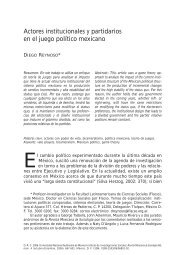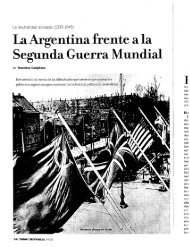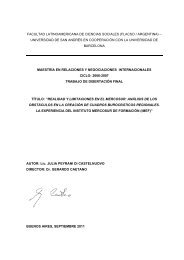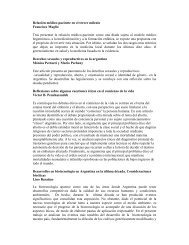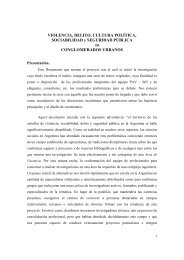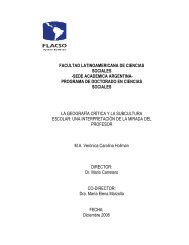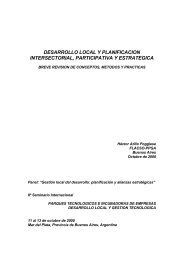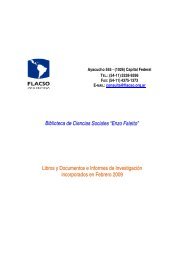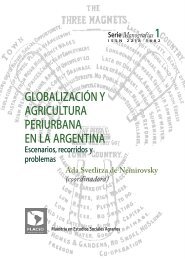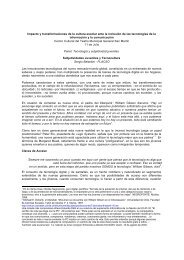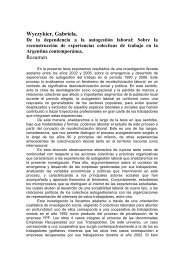Mercedes Botto Andrea Carla Bianculli - Flacso
Mercedes Botto Andrea Carla Bianculli - Flacso
Mercedes Botto Andrea Carla Bianculli - Flacso
You also want an ePaper? Increase the reach of your titles
YUMPU automatically turns print PDFs into web optimized ePapers that Google loves.
Brazil’s total exports, in the case of Argentina this stood at 80%. In qualitative terms, this increase<br />
also benefited Argentina through the diversification of its export supply.<br />
Nevertheless, this was a short-term process and one of limited scope. Different analyses emphasize<br />
that even if the CGP led to an increase in productivity and a better use of installed capacity in both<br />
countries, there were neither significant investments nor important transformations in the structure<br />
of the national supply. In effect, difficulties in the availability and conditions of credit to acquire<br />
capital goods and the perception that this was not definitive hindered the decision-making of<br />
Argentine producers in the medium-term. In addition, the increase in bilateral trade – by 40%<br />
between 1985 and 1988 – was circumscribed to certain sectors, particularly capital goods and wheat,<br />
products of relative importance in macroeconomic terms. Most of the relevant productive sectors<br />
had only a marginal or symbolical participation in the impact of the integration initiative. Moreover,<br />
they did not seem to be interested in assuming a more active role in the near future. These included<br />
the steel and iron industry, different branches of the food sector, and the automotive complex.<br />
For many of those who took part in the narrated events, the PICE was the only experience where<br />
academic results were the source, and, moreover, the unique source of knowledge and advice in the<br />
trade policy decision-making process. This leads us to both the facilitating and inhibiting factors in<br />
this particular research-policy relationship.<br />
A first factor refers to the novelty. This issue was new not only for public officials but for the<br />
private sector involved in the decision-making as well. It should be noted that these were the first<br />
steps promoted by a democratic government after years of military dictatorship. Even if there had<br />
been previous trade liberalization processes – the negotiation of tariff preferences within LAIA<br />
during the 1970s – the military coup would then disarticulate these networks by breaking the<br />
constitutional order and replacing public officials and cabinets. The only sectors that were involved<br />
in this learning process were those related to the most concentrated sectors of the economy and<br />
which also experienced a large economic growth during the military coup – such as the steel and<br />
iron industry, or the automotive and petrochemical industries. However, these sectors did not<br />
participate in the formulation or implementation of the CGP, which was limited to smaller sectors<br />
and industries.<br />
The second element that accounts for the influence academics had vis-à-vis other actors involved in<br />
the decisional process refers to the relative poor capacity or ability of the sector to respond or<br />
produce alternative strategies. In effect, the capital goods industry is not a concentrated sector in<br />
Argentina. Unlike other sectors showing great political leverage – such as the steel and iron<br />
industry, or the automotive and petrochemical industries – it is highly disarticulated and does not<br />
have a strong and clear labour organization. This allowed the executive to design and implement<br />
the sectoral opening without consulting with the actors involved.<br />
Finally, a third element that can help us explain the leading role academia played in the formulation<br />
and implementation of the liberalization process that was launched from 1986 to 1991 refers to the<br />
integration model adopted. A selective, gradual and complementary approach to trade liberalization<br />
24



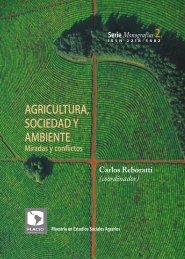
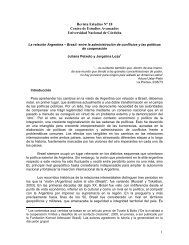
![[P] Disertacion.Melisa.Galvano.pdf - Flacso](https://img.yumpu.com/14596629/1/184x260/p-disertacionmelisagalvanopdf-flacso.jpg?quality=85)
